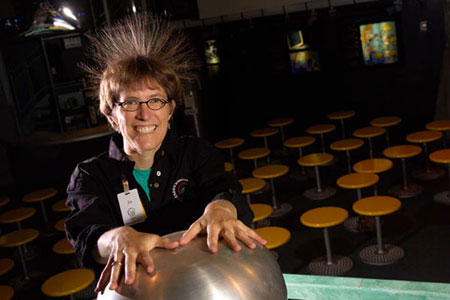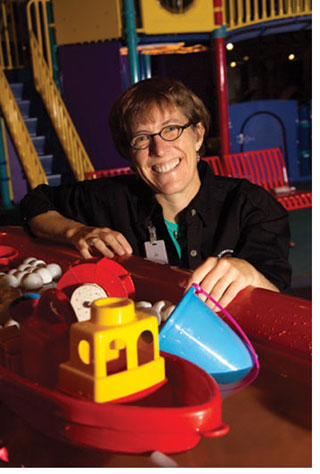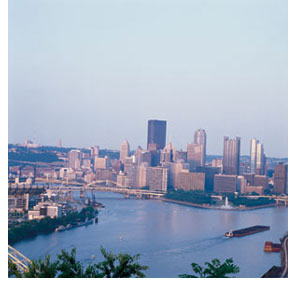Jo
Haas, Energized.
By Jane-Ellen Robinet
 |
Photo:
Harry Giglio
Joanna (Jo) Haas became the Henry Buhl,
Jr., director of Carnegie Science Center in
October 2003, and in less than a year the Science
Center has already begun to show the results
of her administrative philosophy. A dynamic
leader with a down-to-earth style, Jo Haas
at the age of 37 has already logged a decade
of experience at Ohio’s Center of Science & Industry
and the Henry Ford Museum in Detroit, and along
the way demonstrated that she is a rising star
in the field of science center management. As the first woman to head
a Carnegie Museum, she faces the challenges of directing a 13-year-old
successful science center that is a key player in Pittsburgh’s
educational, scientific, and cultural community.
In June, she spoke with CARNEGIE magazine
about new directions for the Science Center
and her impressions of Pittsburgh.
|
CM: You’re
obviously passionate about what you do. What
is it about the business of
science centers that excites you?
JH: My
professional roots are in the science center arena,
and there’s definitely something magnetic
and magic about this business. Science centers are
by nature very vibrant, active places, and that’s
inspiring to me. I’m drawn to those ideals
and thrive in those realities.
There’s always something
new at a science center, too. People learn by doing
things—although some
of us as adults are less comfortable with that concept.
I can’t get enough of the active learning that
weaves its way through the front- and back-of-house
activities here.
Exploring and learning is what we
are all about. That’s
a very noble and energizing work environment, don’t
you think?! We are committed to creating life-long
learners, explorers, inventors…people who aren’t
afraid to test and try things. To be part of a place
with a mission built on invention, constant motion,
and life-long learning is a very natural place for
me, professionally and personally.
CM: Before starting your career, was science something
that interested you?
JH: Well, my formal degree is actually in psychology
and I have a concentration in studio art. I entered
college with the intention of emerging as an art teacher
or an art therapist. Almost before I knew it, the principles
I learned and grew to appreciate through these courses
of study—plus my love of exploring the world
around me and being encouraged by my family, from the
time I was very young, to be inquisitive and expressive— crystallized
in my mind the importance of life-long learning and
life-long creating. That appreciation equipped me well
for my first position planning and running education
programs at Ohio’s Center of Science & Industry
in Columbus (COSI). And it’s what immediately
attracted me to Carnegie Science Center—the fact
that this institution is absolutely committed to being
creative, thoughtful, and resourceful in the way it
engages people of all ages in the process of learning.
 CM: After a year in your new post, what are some of
the things you feel the Science Center does well? What
are some of the areas that you think more could be
done with? CM: After a year in your new post, what are some of
the things you feel the Science Center does well? What
are some of the areas that you think more could be
done with?
JH: One thing I was struck by very
early on is the connectedness of this institution with
the Pittsburgh
community. In fact, I had the privilege of riding on
the Science Center’s coat tails to receive the
2003 National Award for Museum Excellence, bestowed
on Carnegie Science Center by the Institute for Museum
and Library Services at the White House. The award
recognized Carnegie Science Center for its exceptional
service to the community. We are clearly a national
bellwether for community outreach and have helped to
set the national standard and others recognize that.
This institution addresses
individuals and organizations
in a very personalized way. Many science centers
become incredibly institutionalized.
It is important to be
institutional in some respects because you gain a
little bit of polish and efficiency,
but at the same time
you don’t want to lose the ability to relate
to people in a very personal, passionate way. That
is one of the real differentiators of this institution.
It is the work of every team
member and every board member
affiliated with Carnegie Science
Center, and
it was clearly the work of my predecessor Seddon
Bennington, whose real strength was in casting
seeds, establishing
partnerships and engaging the community in a very
powerful way. We have a tremendous network well
established. And it has been
my experience that every member
of
this team feels a sense of responsibility to the
community.
I’d like to see us capitalize on that and
watch our community connections flourish in new
and strategic
ways.
Our biggest challenge is to
gain—at
the same time—a sense of discipline, business
savvy, and muscle, and an attractions-oriented
mindset so we are
poised to expand also beyond this community.
Seventy three percent of the people we see and
serve here
on the North Shore (not including those we see
through
our outreach programs) are from Allegheny County
and the four closest counties.
That’s very
powerful, but it also begs the question: What
about the people who are within an hour drive,
or a few hours drive of us? It’s not
out of the question to spend the day here.
But what
is it that
is drawing them? What is it about the Science
Center’s
personality or the visitor experience that
is compelling enough for them to consider us
a destination?
Pittsburgh has amazing assets.
The Science
Center alone is an amazing asset. And if you
begin adding
other
experiences, you’ve created a whole weekend
of stimulating, intellectual, fun things to
do. You start
your visit at the Children’s Museum,
then go to a baseball game.
Spend all day at
the Science Center. Wake up with a visit to
the dinosaurs at the Museum
of Natural
History,
enjoy a matinee in the Cultural District, and
you’re
on your merry way home by late Sunday afternoon.
By then you have fed the economic coffers and
sustained
the cultural organizations. There’s a
lot this institution can be doing for economic
development as
a regional destination attraction.
That’s
one of our big opportunities. Attract and engage.
And I’m not just talking about flash-in-the-pan
stuff. I’m talking about what we can
do to change people’s minds about science
(which is coming back to our mission), to establish
inquisitive, thoughtful,
curious, competent people of all ages…I
don’t
want to just touch the kids. Science matters.
Every day science, math, and technology drive
both simple
and complex things in the world around us.
The Science Center can play a significant role
in demystifying
and revealing the science in our everyday lives.
CM: The Rangos Omnimax Theater
seems to be going through some
changes. Not all of its
feature
films are science-related
or related to an exhibit. What is behind that
program policy?
JH: An IMAX® or OMNIMAX® theater
inside an institution like Carnegie Science
Center is a terrific
way to build, expand, and change the programmatic
opportunities for visitors. Some institutions
with large-format theaters
integrate those theaters totally with their
exhibits and
programs. But that’s a difficult economic
model because it reduces your opportunities
to run your theater
at off times, when it may not make sense to
have the whole building open.
Recently, more
cultural organizations with
large-format theaters have been building them
so they can
run easily in that stand-alone mode—with
separate entrances to allow late-night shows,
early-morning shows, and
off-day shows. Here at the Science Center,
we are using the OMNIMAX® to attract new
audiences, some of whom may or may not be interested
in a particular exhibit.
And we are becoming very successful at that.
We
have had some of the best runs in the business
on films like Lewis & Clark, Everest, and
Coral Reef. We have also just recently made
a name for ourselves
in the Hollywood blockbuster release business.
We were number-one nationwide and world-wide
in pre-sales for
Harry Potter and the Prisoner of Azkaban.
The challenge is to strike a balance. If you
look at our schedule for the year, we had been
running
Jane
Goodall and Lewis & Clark.
We also had Young
Black Stallion from Disney over the holidays.
We brought in NASCAR, which is a terrific science
show, and we
have been bringing in a new audience with that
product. We had Harry Potter this summer, and
we are premiering
Forces of Nature (a National Geographic film)
in early fall.
There is clearly great potential
for synergistic
programs once or twice a year. Maybe there
ends up being an
exhibition and an OMNI film on the same theme.
Maybe there is an exhibition and a set of education
programs
that make sense together. For example, this
fall we have the Titanic Science exhibit, and
we’re excited
about that, and plan to marry our OMNI film—Ghosts
of the Abyss—with this exhibit as a thematic
set of offerings.
CM: Do you see the Science Center expanding
in the future?
JH: We’re trying now
to answer these questions: Is the best expansion
of the Science Center a major
physical expansion? Is it an intellectual expansion
or a programmatic expansion? Is it an architectural
expansion? Or is it some unique combination
of all those things?
We presently run satellite
outreach operations,
including an amazing facility in the Hill District
called Mission
Discovery. Should we launch a whole network
of such community-based satellite operations?
What
things
should we continue, expand, add? Those are
the questions our
team, board, and the broader community will
be thinking through in the next few months.
We as a board and a team embraced a strategic
planning process in January. It laid out a
three-phase process
that will culminate with a completed strategic
plan and then launch us into expansion planning.
We are
in the “exploration phase” right now and,
hopefully, we will soon begin to determine what the
expansion will look like.
CM: What, if any, are the physical challenges
of the current Science Center building?
JH: Well, the building is 13 years old and
it does have significant challenges for today’s high
attendance levels. Literally half of the main building
is circulation space, and we have too little exhibit
space. If you look at service spaces, the entry, ticketing,
and food services are all problematic. There are many
challenging aspects of this building today, and our
expanding attendance exacerbates those issues. We want
to be able to capitalize on the great learning and
fun that happens in places like SportsWorks, the fourth
floor Exploration Station and SciQuest for example.
We need more spaces ideally suited to allow visitors
to imagine, laugh, explore, and learn!
CM: Do you plan to collaborate much with the
other Carnegie Museums?
JH: I see tremendous opportunities
for collaboration and I am a collaborator by
nature. One of the
things that was very appealing to me was the
opportunity
to step into a complex of institutions and
be part of
the leadership team that helps figure out how
to bring those partnerships to life.
One of
the things on our future radar screen is a
visitor experience centered around insects.
We’ve been
in preliminary discussion with the Natural
History Museum about this. There’s a
great OMNI film, called Bugs, and they have
a terrific collection of
insects at the Natural History Museum. So we
are beginning to talk with them about how to
bring those things together,
but we don’t have the answers yet. Collaborations
of all kinds are certainly in the cards.
 CM: What are your impressions of Pittsburgh? CM: What are your impressions of Pittsburgh?
JH: I love Pittsburgh. It is
the most comfortable place I’ve ever
lived. I grew up in Northern Kentucky and went
to school in Cincinnati. Then I graduated
from Denison University, and moved immediately to
Columbus, Ohio. I lived there for almost 10 years.
Then I went to Michigan, where I lived for five years
in three different communities.
But there’s
something about Pittsburgh, and the fabric of Pittsburgh.
I have never seen so many individuals
so passionate about the concept of community. These
are people, and I am now one of them, who care about
where they live, care about one another, invest enormous
amounts of time, energy, money, into those things they
believe in. There is an incredible, palpable sense
of community.
CM: Perhaps that comes from an inferiority complex
of sorts, from being an old industrial city that
has worked to transform and improve itself?
JH: There should be no inferiority
complex here. No one who lives here, and certainly
no one who has
lived
here for a long time, should feel inferior about
this city, this place, or the people who are part
of it.
With all the cultural resources here, I’m
like a kid in a candy store. I could keep myself
busy for
a month of Sundays just tooling around museums.
I’ve
been to the opera, the symphony, the Broadway productions,
the lecture series. There’s just a ton going
on. I don’t think any other community can
hold a candle to how accessible it all is.
Intellectually,
this community is extraordinary.
I’m
not sure whether this is because I am looking
through a new lens as the leader of the Science
Center,
or whether I am truly in a place of much more
magnitude than ever before. The university research
and business
communities are transforming the world’s
intellectual landscape every day.
I have felt
incredibly welcomed. I have had enormous numbers
of people reach out to me. I don’t take
that lightly, and it’s not something I
feel entitled to. That’s something I genuinely appreciate, and
feel indebted by. _________________________________________________________________
Back to Contents |